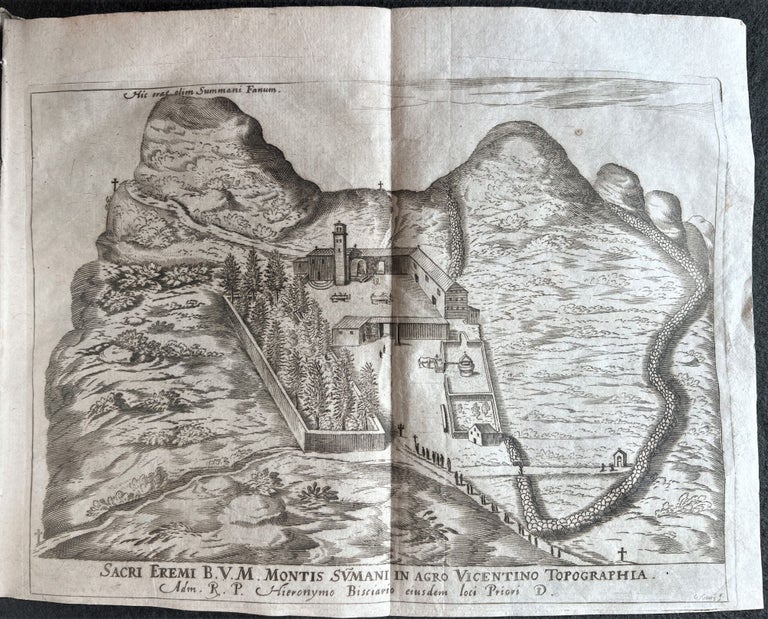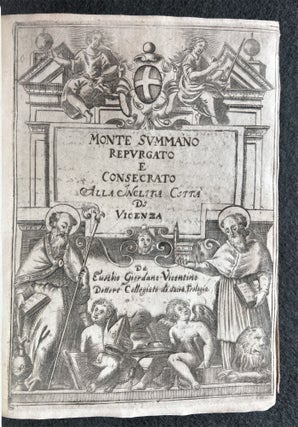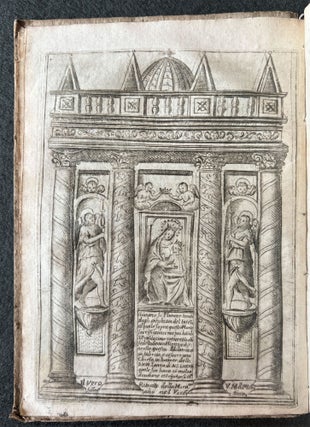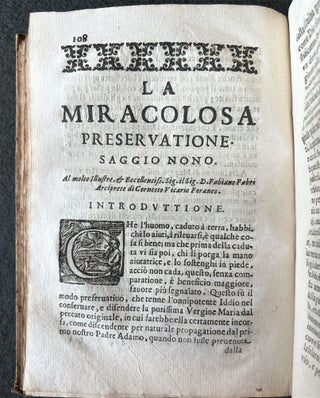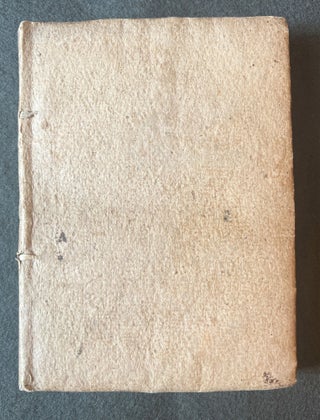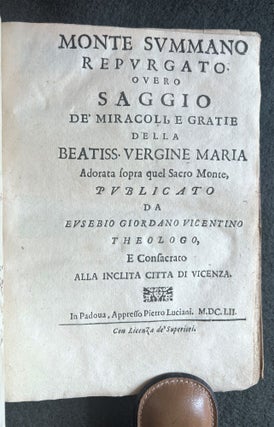Monte Summano repurgato, ouero, Saggio de' miracoli, e gratie della beatiss. Vergine Maria Adorata sopra quel Sacro Monte. Padua: appresso Pietro Luciani, 1652.
4to (197 x 143 mm). [6], 200 pages, [1] leaf (errata). Additional architectural engraved title with angels and saints, engraved folding plate showing a bird’s-eye view of the sanctuary and surrounding mountains, signed G. Georgi f., full-page engraving of the painting of the Virgin (shaky impressions of frontispiece and Virgin engraving), woodcut initials, typographic head-pieces. Contemporary carta rustica, manuscript title label on spine. Provenance: ms. correction supplying a word in the dedication (not corrected in the errata); late 18th-century manuscript note on the subsequent history of the shrine, on verso of engraved title; 20th-century armorial bookplate of Petrus Magnanius (”Ex-libris Petri Magnanii”), shelfmark label on spine.***
An idiosyncratic miracle book and description of the pilgrimage site of Santa Maria del Summano, on the Monte Summano, a small peak in the southern Vicentine Pre-Alps. The author was a monk of the Congregazione dei poveri eremiti di San Girolamo (Frates heremitae sancti Hieronymi), which had managed the hermitage since the 15th century. This greatly enlarged second edition includes Giordano’s shorter 1626 work on the same subject, Monte Summano ridutto a migliore cultura et celebrato con prosa et poesie sacre, but it contains much more, as explained in his dedication to the ten Deputati of the city of Vicenza, signed 7 September 1652.
Giodarno devotes the main part of the book to the miracles of the Virgin of Summano, arranged thematically in 12 chapters or “Saggi,” each dedicated to a different local notable or church dignitary. In prolix prose, laced with metaphors and aphorisms, often prefacing each account with sermon-like reflections, Giordano describes miracles of resurrection (La Morte debellata); recovery from illnesses: hernias, epilepsy, poisonous bites, etc. (Gli Egli curati); divine revelations (I Ciechi illuminati); exorcism (Il Demonio scacciato); healing of wounds (Le Ferite sanate); rescues from marauding soldiers or in battle (La Celeste difesa); survival of lightning strikes (Il Fulmine arrestato); shipwrecks averted (La Procella abbonacciata), survivals after falls from horses, cliffs, etc. (La Miracolosa preservatione) [this includes an account of surviving to a very old age, that was supposed to be in the second chapter but was omitted]; liberation from prison or from death sentences (La Sentenza frastornata); healing from plague (La Peste curata), with preliminary reflexions on David’s choice of punishment (hunger, war, or the plague); and rain after a long drought (La Pioggia impetrata).
A colorful description of the hermitage, its approach and surroundings, follows. Giordano describes the pilgrim toiling up the “horrible” mountainside, his fear softened by the sight of the many wildflowers, his relief upon arriving in the elevated site, the glorious views from the top of the mountain (still planted with a very large crucifix), and the interior of the church, as well as its splendid cistern. The sanctuary’s origins are summarized at the very end of the book, in one of several epigraphic transcriptions from the shrine: Legend had it that in ancient times a statue of Pluto, the god of the underworld (the Summus Manium), was worshipped on the site. In the year 77, San Prosdocimo, a noble Greek and disciple of the Apostle Peter, destroyed the pagan idol statue and was instructed by God to build a church there. In fact it seems that the sanctuary dates to the 14th century; a wooden statue of the Virgin, probably dating from the 15th century, was moved to the church of nearby Piovene when the sanctuary was suppressed in 1777. Its buildings fell into ruin, and the church was rebuilt in the late 19th century.
The paratext of this edition is unusual. Opening and closing the main section are two separate sets of dedications, letters to the Virgin, and notes to the reader. The second dedication is addressed to the 12 dedicatees of the preceding Saggi; Giordano uses it to vent his indignation at an unnamed individual who “brutally” and irreligiously declined to figure as a dedicatee, “not wishing his name to appear in a book about the Madonna.” In the final letter to the reader, the author lets loose a litany of complaints about the costs and annoyances of printing, describing as “claws of the harpies” the typesetters, compositors and pressmen, who always want to be paid “a prezzo,” not to mention the costs of paper, and even of printed waste... And the errors! For every mistake that one finds 7 others crop up, and then 70 more, after having “read, and reread, examined, and reexamined, corrected, and recorrected, my god so many mistakes: truly one needs the eyes of an Argus...” Giordano follows this rant with a list of titles of works that he would have liked to publish, were it not so darned difficult, as he would rather read the recipe of an old gout-ridden, paralytic doctor than reread his own prose.
The engraved panoramic view of the sanctuary nestled between the peaks of the Monte Summano, by the Venetian engraver Giovanni Georgi, shows the church and its tower, wooded enclosure, outbuildings, gardens, well, and a horse, with a line of approaching pilgrims climbing up the mountain. The engraving of the Vero Ritratto of the Virgin, probably also by Georgi, depicts the painting of the Madonna and child set within the central compartement of a colonnade, flanked by statues of angels; the engraved text below summarizes the legend of the sanctuary.
This entertaining devotional work is rare. I locate one copy in the US, at the University of Dayton, and none of the 1626 edition. Michel & Michel, Répertoire des ouvrages imprimés en langue italienne au XVIIe siècle conservés dans les bibliothèques de France IV, 49. On Georgi, cf. Thieme Becker 13:426. Item #4175
No longer available
Status: On Hold

